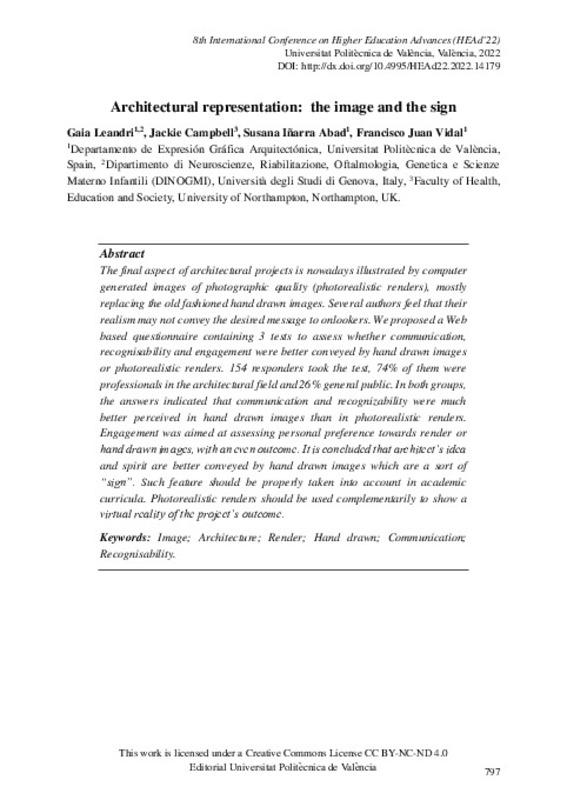JavaScript is disabled for your browser. Some features of this site may not work without it.
Buscar en RiuNet
Listar
Mi cuenta
Estadísticas
Ayuda RiuNet
Admin. UPV
Architectural representation: the image and the sign
Mostrar el registro sencillo del ítem
Ficheros en el ítem
| dc.contributor.author | Leandri, Gaia
|
es_ES |
| dc.contributor.author | Campbell, Jackie
|
es_ES |
| dc.contributor.author | Iñarra Abad, Susana
|
es_ES |
| dc.contributor.author | Juan Vidal, Francisco
|
es_ES |
| dc.date.accessioned | 2023-02-15T08:15:11Z | |
| dc.date.available | 2023-02-15T08:15:11Z | |
| dc.date.issued | 2022-05-31 | |
| dc.identifier.isbn | 9788413960036 | |
| dc.identifier.issn | 2603-5871 | |
| dc.identifier.uri | http://hdl.handle.net/10251/191844 | |
| dc.description.abstract | [EN] The final aspect of architectural projects is nowadays illustrated by computer generated images of photographic quality (photorealistic renders), mostly replacing the old fashioned hand drawn images. Several authors feel that their realism may not convey the desired message to onlookers. We proposed a Web based questionnaire containing 3 tests to assess whether communication, recognisability and engagement were better conveyed by hand drawn images or photorealistic renders. 154 responders took the test, 74% of them were professionals in the architectural field and 26% general public. In both groups, the answers indicated that communication and recognizability were much better perceived in hand drawn images than in photorealistic renders. Engagement was aimed at assessing personal preference towards render or hand drawn images, with an even outcome. It is concluded that architect’s idea and spirit are better conveyed by hand drawn images which are a sort of “sign”. Such feature should be properly taken into account in academic curricula. Photorealistic renders should be used complementarily to show a virtual reality of the project’s outcome. | es_ES |
| dc.format.extent | 9 | es_ES |
| dc.language | Inglés | es_ES |
| dc.publisher | Editorial Universitat Politècnica de València | es_ES |
| dc.relation.ispartof | 8th International Conference on Higher Education Advances (HEAd'22) | |
| dc.rights | Reconocimiento - No comercial - Sin obra derivada (by-nc-nd) | es_ES |
| dc.subject | Image | es_ES |
| dc.subject | Architecture | es_ES |
| dc.subject | Render | es_ES |
| dc.subject | Hand drawn | es_ES |
| dc.subject | Communication | es_ES |
| dc.subject | Recognisability | es_ES |
| dc.title | Architectural representation: the image and the sign | es_ES |
| dc.type | Capítulo de libro | es_ES |
| dc.type | Comunicación en congreso | es_ES |
| dc.identifier.doi | 10.4995/HEAd22.2022.14179 | |
| dc.rights.accessRights | Abierto | es_ES |
| dc.contributor.affiliation | Universitat Politècnica de València. Departamento de Expresión Gráfica Arquitectónica - Departament d'Expressió Gràfica Arquitectònica | es_ES |
| dc.contributor.affiliation | Universitat Politècnica de València. Escuela Técnica Superior de Arquitectura - Escola Tècnica Superior d'Arquitectura | es_ES |
| dc.description.bibliographicCitation | Leandri, G.; Campbell, J.; Iñarra Abad, S.; Juan Vidal, F. (2022). Architectural representation: the image and the sign. En 8th International Conference on Higher Education Advances (HEAd'22). Editorial Universitat Politècnica de València. 797-805. https://doi.org/10.4995/HEAd22.2022.14179 | es_ES |
| dc.description.accrualMethod | OCS | es_ES |
| dc.relation.conferencename | Eighth International Conference on Higher Education Advances | es_ES |
| dc.relation.conferencedate | Junio 14-17, 2022 | es_ES |
| dc.relation.conferenceplace | Valencia, España | es_ES |
| dc.relation.publisherversion | http://ocs.editorial.upv.es/index.php/HEAD/HEAd22/paper/view/14179 | es_ES |
| dc.description.upvformatpinicio | 797 | es_ES |
| dc.description.upvformatpfin | 805 | es_ES |
| dc.type.version | info:eu-repo/semantics/publishedVersion | es_ES |
| dc.relation.pasarela | OCS\14179 | es_ES |








